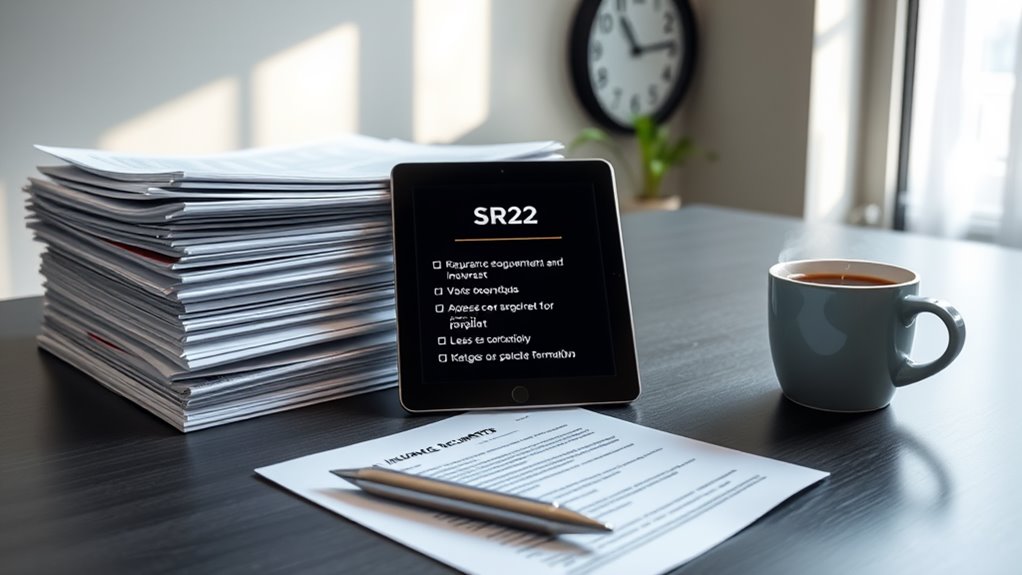Maneuvering Ohio's insurance documentation requirements can feel like piecing together a complex puzzle. To guarantee you don't miss any vital pieces, you need to start by gathering essential personal identification documents. Each step, from proving residency to understanding your driving history, is fundamental for compliance. But what happens if you overlook a small detail? Uncovering the nuances of these requirements could save you from potential pitfalls and financial risks.
Key Takeaways
- Ensure all personal identification documents, like your driver's license and birth certificate, are consistent and organized for submission.
- Gather proof of residency using valid Ohio identification, utility bills, or official documents from governmental agencies.
- Obtain your Ohio driving record, which can be requested online or in-person, to track your driving history accurately.
- Comply with Ohio's minimum insurance coverage requirements of $25,000 for bodily injury and property damage to avoid legal penalties.
- Regularly review your insurance policy to consider additional coverage options and ensure adequate financial protection.
Understand the Purpose of SR22 Insurance

Although you may not think about it until faced with a driving violation, understanding the purpose of SR22 insurance is vital for maintaining your legal driving privileges.
An SR22 isn't an insurance policy but a document showing you meet your state's minimum auto liability insurance requirements. It serves as proof of financial responsibility, particularly after serious offenses like DUIs or reckless driving. In Ohio, specific violations trigger the need for an SR22, ensuring compliance with state regulations. Filing this form involves your insurance provider submitting it to the DMV, with fees typically ranging from $20 to $50. States dictate the required filing duration for the SR22, which is usually three years. Additionally, some drivers may need to complete a defensive driving course to help reduce the risk of further violations.
Maintaining continuous coverage is important; any lapse in insurance can lead to penalties and further complications in reinstating your driving privileges.
Gather Necessary Personal Identification
Gathering the necessary personal identification is an essential step in meeting Ohio's insurance documentation requirements.
Start by collecting documents that confirm your full legal name, such as a driver's license or state ID. You'll need proof of your date of birth, typically a birth certificate or passport.
Begin gathering documents that verify your legal name, including a driver's license or state ID, along with your birth certificate or passport for date of birth proof.
Verify you provide evidence of legal presence in the U.S., which could include a passport or permanent resident card. Don't forget to include your Social Security number, either via your Social Security card or W-2 form.
Additionally, prepare a photo ID, like a state driver's license. Consistency is key—make certain names and dates match across all documents.
Organize everything using a checklist to avoid incomplete submissions.
Provide Proof of Residency
Once you've collected the necessary personal identification, the next step involves providing proof of residency.
You'll need to gather documents like a valid Ohio driver's license or identification card. Utility bills from two different providers also work well. Additionally, professionally issued documents from governmental agencies, tax documents like property deeds, or even hunting and fishing licenses can serve as valid proof.
Remember, having accurate proof is essential for compliance with federal and state requirements, and it's often needed for insurance eligibility and voter registration.
To streamline the process, create a checklist of required documents, manage timelines effectively, and verify that your documentation comes from diverse, recognized sources to avoid any potential delays or complications.
Document Your Driving History

To guarantee you're fully prepared for insurance application processes or legal requirements, documenting your driving history is essential.
Start by obtaining the appropriate Ohio driving record, such as the three-year driving record abstract, which details accidents and violations. You can acquire this online through the Ohio BMV website, in-person at a Deputy Registrar License Agency, or by mail for a small fee.
To start, obtain your Ohio driving record online, in person, or by mail for important details on accidents and violations.
Understanding the points system is vital; accumulating 12 points in two years can lead to license suspension. Keeping your record clean can help maintain lower insurance rates, while completing approved driving courses can remove points.
Always be aware of the legal implications surrounding your records, especially regarding privacy and consent requirements.
Ensure Compliance With Minimum Coverage Requirements
Maintaining a clean driving record is only one part of your overall insurance strategy; ensuring compliance with Ohio's minimum coverage requirements is equally important.
In Ohio, you must have at least $25,000 per person for bodily injury, $50,000 total per accident, and $25,000 for property damage. Driving without this insurance is illegal and can lead to severe penalties.
It's vital to understand that minimum coverage mightn't fully protect you if accidents result in higher damages, potentially leaving you financially vulnerable.
To safeguard your assets, consider additional coverage options, such as uninsured/underinsured motorist protection and higher liability limits.
Regularly review and update your policy to maintain adequate protection against financial risks.
Choose the Right Insurance Provider
Choosing the right insurance provider is crucial for securing the coverage you need while traversing Ohio's complex insurance landscape. Start by evaluating the provider network; CareSource stands out with its extensive options, ensuring you access various health care services.
Look for features like no copayments for medical and behavioral health services, which enhance affordability. Consider providers that offer additional support, such as free transportation to appointments and user-friendly tools to find doctors and prescriptions.
All-encompassing coverage is important, especially for low-income families. Finally, check for educational resources and reward programs that promote wellness. These factors will help you make an informed decision, ensuring you receive quality care without unnecessary financial strain.
Keep Track of Filing and Renewal Deadlines

Keeping track of filing and renewal deadlines is vital for guaranteeing your insurance coverage remains uninterrupted and compliant with Ohio's regulations.
Here are key deadlines to monitor:
- Annual Title Filings: Due by January 15 each year for the previous period.
- Claim Notifications: Notify your insurer of any loss within a reasonable timeframe.
- Claim Acknowledgment: Insurers must respond to claims within 15 calendar days.
- Renewal Notices: Expect reminders well in advance of your policy's expiration date.
Maintaining electronic records of your filings is essential.
Regularly review updates from the Ohio Department of Insurance to stay informed about any regulatory changes that may affect your deadlines.
Keeping organized guarantees you're always compliant and protected.
Conclusion
Maneuvering Ohio's insurance documentation requirements can feel like assembling a puzzle. Each piece—your ID, proof of residency, and driving history—must fit perfectly to create a complete picture. Just like a missing puzzle piece can leave an image incomplete, overlooking any detail can lead to complications. By staying organized and proactive, you guarantee your insurance remains compliant and effective, protecting you from potential financial pitfalls. So, take the time to put all the pieces together and secure your peace of mind.

